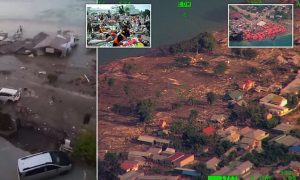by Dayang Saliah Noorshamsiah

At least 2,045 people were confirmed dead while as many as 5,000 others are remained missing during a devastating 7.5 – magnitude earthquake and tsunami that struck Palu capital and Donggala Regency, Central Sulawesi the epicenter of the Minahasa Peninsula, one of the four principal peninsulas on the island of Indonesia on September 28th, 2018 (The Time, 11th October 2018).
Series of natural disasters happening around our neighboring regions recently include the Typhoon Mangkhut which ripped through the northern Philippines’s land of Luzon, the earthquake in Lombok and the most recent deadly natural disaster in Palu, Sulawesi, should serve as a lesson to us, Malaysians. As a country that exists on the same continent, although from its geographical location Malaysia’s position is outside the ring of fire which accordingly making us protected from most major natural disasters, yet it does not necessarily mean that we should underestimate of any future possibilities.
Apparently, Malaysia is not completely safe from major natural disasters. As evident, the 1976 Sabah Earthquake, 2004 Tsunami in a few coastal areas in Peninsular Malaysia which reportedly has killed around 67 peoples as well as the Sabah Earthquake 2015 which has killed about 18 people. As a matter of fact, since the 2004 Indian Ocean Earthquake which has led to Tsunami in Aceh, Indonesia, one of the deadliest natural disasters in history, the interest towards tsunami risks in Malaysia has also heighten. These series of events are the evident that our beloved country has experienced and may possibly continue to experience natural disasters and calamities that will affect the lives of many despite of its geographical position. Perhaps up to this date, we are yet to experience deadly major natural disasters but with the series of the mentioned incidents, it shows that Malaysia is also prone to those major disasters. Of course, as some may claims, natural disasters are the act of God and it is inevitable. But the real question is, how well do we have prepared should we encounter the next natural disaster or calamity?
It is undeniable that our national armed forces, fire departments and police force units as well as other emergency response teams are well equipped and trained to react during times of emergencies. But to which extent of emergency situation that we are truly trained and equipped remain the main issue. Given the situation that we encountered so far are the flashfloods and landslides. Questions arise on how if we truly facing a major natural disaster like what happened in Indonesia and Philippine off late? Nevertheless, to fully rely on these teams alone during such unfavorable situation is not enough. What we also need is well-educated and prepared public on how to react should we faced such emergencies in order to at least minimizing the casualties if not to fully avoiding it. Often during such unfavorable situation, public falls victims – panic stricken, confusion and fear – are the common reactions. Hence, it is important that the public are prepared both mentally and physically should any unfortunate events strike. At least with the knowledge of how to react during the emergency situation they can save their own and their families’ life while waiting for further assistance. That is why an environmental awareness and emergency evacuation plan education is very much important among the public even in a country like us, Malaysia.
In this age of information and media sophistication, there are many ways on how environmental awareness and emergency evacuation plan education can be executed by using the media as a medium. Especially with the growing popularity of the social media platform among Malaysia media users, messages can be disseminated instantaneously at all level of people through various social media platform. Emergency evacuation plans campaigns and education for example can be carry out massively using the social media at low very low costs to investigate awareness among the public on the importance of natural disaster preparations. Apart from that, rescue, recovery and rebuilding efforts are also vital to be improved and focused on.
Having the best forms of disaster preparedness goes beyond possessing best facilities and services. The essential part is the infrastructure, manpower and strategic emergency evacuation plans should be constantly maintained, restructured and updated. There is no harm putting forward early prevention and preparation as we will never know when natural disaster may strike. Even if its not major disasters like earthquake, typhoon or tsunami, the annual flash flood that keep on happening in Malaysia every year like a clockwise is also can regards as natural disaster that required serious measures. Not to mention the Highland Towers landslide in 1993, the Cameron Highland mud flood in 2013 are also among other examples of emergency situation. Responsibilities to react during such unfortunate event does not only fall on the government or the emergency response teams alone but on the public as well. Saving and safeguarding lives is not only the job of those who paid or trained but also is the responsibility of each and everyone on this land. In the end, assuming Malaysia is safe from natural disaster is totally wrong and the whiplash of tsunami 2004 has proven that it is time for us Malaysia to start taking it seriously preparing for any possibilities that may happened in the future.